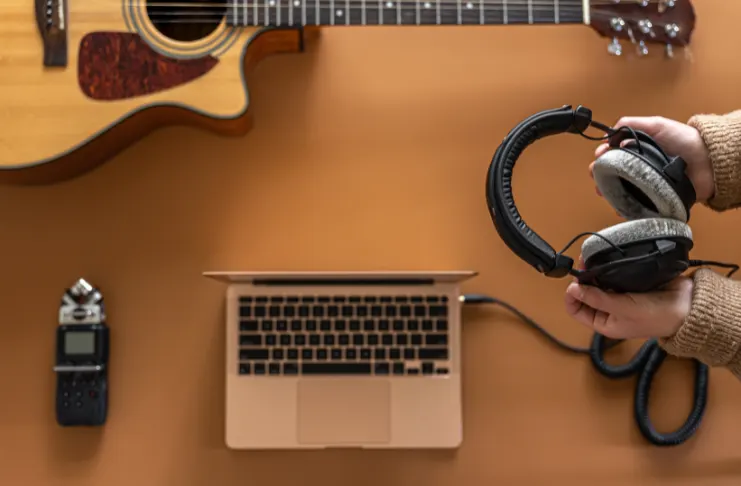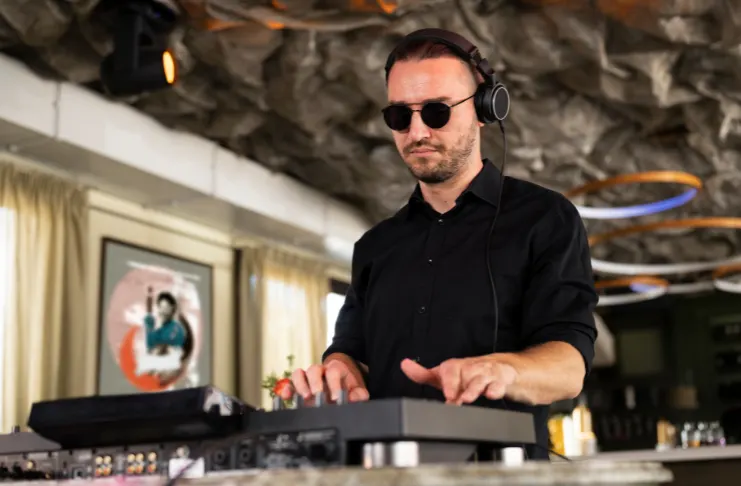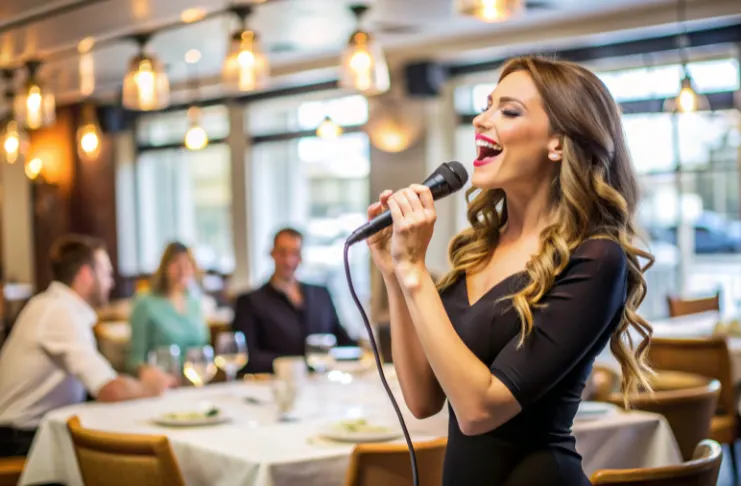The ambiance of a restaurant extends far beyond décor and lighting, as music influences the overall experience. Restaurant music strategy is an invisible yet powerful force that shapes every aspect of the dining experience. From the moment guests arrive to their final bite, the carefully curated soundtrack influences their behavior, spending patterns, and overall satisfaction.
Understanding how music affects restaurant sales is crucial for modern restaurateurs seeking competitive advantages. The right soundtrack for playing music doesn’t just fill silence; it creates emotional connections that boost customer satisfaction, loyalty, and revenue.
The Science Behind How Music Affects Restaurant Sales
Enjoyable background music strongly shapes the dining experience and customer spending. Small changes in music, such as using slower background music, affect mood, perception, and behavior. A study found that music boosted restaurant sales by 9.1% over five months, showing how crucial the right playlist can be for driving revenue.
- Well-chosen music enhances guests’ views of food quality, service, and ambiance for memorable visits.
- Moderate volume and slower tempos promote relaxed talks, longer stays, and higher spending.
- Louder or faster music speeds table turnover but may lower check size and satisfaction.
- Different genres trigger emotions—classical signals quality, jazz adds sophistication, pop attracts youth, and acoustic creates intimacy.
Best Background Music Genre Selection Strategies

Selecting the right music genre is essential to creating the desired ambiance that resonates with your target audience and enhances your restaurant’s brand and the dining experience.
Classical Music for Fine Dining Establishments
Elegant classical music does more than elevate ambiance—it subtly signals quality, calm, and class to every guest.
- String quartets, piano solos, and orchestral arrangements enhance perceived value and justify higher prices.
- Classical compositions stimulate the mind without overpowering conversation, ideal for romantic or professional settings
- Guests exposed to classical music tend to linger and spend more per visit
- Baroque pieces suit lighter daytime moods, while romantic symphonies elevate evening dining experiences
Using classical music for restaurants as part of your restaurant music strategy can set the tone for upscale experiences that drive both satisfaction and sales.
Jazz and Blues for Sophisticated Ambiance
Jazz creates a sophisticated, comfortable vibe with its engaging, improvisational style. Instrumental jazz avoids distracting lyrics, while vocal jazz fits when lyrics enhance conversation.
Blues adds emotional depth, perfect for comfort food spots and wine bars. It helps create a warm, inviting atmosphere.
Contemporary and Pop Music for Casual Dining
Modern pop music energizes casual dining spaces and connects strongly with younger guests.
- Popular hits create lively atmospheres that encourage socializing and repeat visits
- Regularly updated playlists prevent listener fatigue and keep the experience fresh
- Professional curation balances familiar favorites with new tracks and seasonal themes
- Filtering explicit content helps maintain a family-friendly environment throughout service hours
A well-managed pop playlist is a key part of a restaurant’s music strategy, designed to increase restaurant footfall with music among younger demographics.
Creating the Perfect Restaurant Music Strategy

Understanding your audience in the restaurant industry and adapting music based on demographics, time of day, and seasonal moods ensures a seamless dining experience that enhances customer engagement and comfort.
Understanding Your Target Demographic
Understanding your customer demographics is essential for crafting an effective restaurant music strategy.
- Age, income, culture, and dining habits shape musical preferences and responses
- Baby boomers favor classics and lower volumes, while younger guests lean toward energetic, modern genres
- Restaurants serving mixed-age groups must carefully balance music to please all segments
- Cultural and lifestyle differences, such as urban versus suburban patrons, influence ideal soundtrack choices
Tailoring music to your audience ensures that most restaurant owners’ music strategy maximizes guest satisfaction and boosts sales.
Time-Based Programming Throughout Service Hours
Different meal periods call for tailored music to enhance the dining experience throughout the day.
- Gentle, uplifting music like acoustic folk and soft jazz suits morning service and breakfast settings
- Mid-tempo tracks during lunch balance the needs of quick business diners and those seeking a relaxed meal
- Evening playlists feature richer, more complex compositions that complement dinner and encourage premium orders
- Thoughtful programming by service time helps increase restaurant footfall with music while boosting sales
A well-timed sound system music strategy ensures your restaurant atmosphere supports guest moods and maximizes revenue across all dayparts.
Seasonal and Holiday Programming
Seasonal and weather-aware music programming helps restaurants connect emotionally with their guests throughout the year.
- Spring playlists focus on themes of renewal and freshness to match the season
- Autumn music uses warmer, reflective tones that create cozy dining atmospheres
- Holiday music requires a careful balance to engage celebratory moods without overwhelming guests
- Weather-responsive selections adapt to local conditions, like comforting tunes on rainy days or upbeat tracks on sunny ones
Incorporating seasonal and weather-aware music programming into your restaurant music strategy can deepen guest engagement and help increase restaurant footfall with music all year round.
Increase Restaurant Footfall With Music: Marketing Through Sound

Integrating unique sonic branding, social media-friendly music, and live performances creates memorable experiences that deepen customer loyalty and drive business growth.
Creating Signature Sonic Branding
Creating a unique sonic identity can set a restaurant apart and build lasting customer connections.
- Sonic branding uses consistent musical themes to strengthen brand recognition across all touchpoints
- Signature playlists evoke positive memories and enhance emotional attachment to the dining experience
- Customers often return because they associate specific music with comfort and quality service
- Investing in sonic branding boosts customer loyalty and encourages word-of-mouth referrals
A strong restaurant music strategy that includes sonic branding can become a powerful tool to increase restaurant sales and guest retention.
Social Media and Music Integration
Background music plays a key role in shaping how diners share and promote their restaurant experiences online.
- Engaging soundtracks enhance the appeal and perceived quality of social media posts by customers
- Familiar songs encourage guests to share and discuss music, boosting organic online engagement
- Music-centered content like playlists or “now playing” features fosters a sense of community and brand connection
- Restaurants that leverage music in social media can increase restaurant footfall with music-driven organic marketing
Integrating music into your restaurant’s music strategy not only enriches the in-person experience but also expands your digital reach and customer base.
Live Music Events and Special Programming
Live music adds a distinctive touch that can elevate a restaurant’s appeal and profitability.
- Scheduled live performances create unique experiences that encourage reservations and justify premium pricing
- Special event programming for holidays or anniversaries strengthens community ties and boosts sales
- Well-chosen performers matched to venue size and audience enhance the atmosphere without disrupting service
- Poorly managed live music risks overwhelming operations and detracting from guest satisfaction
Incorporating live music thoughtfully into your restaurant music strategy can increase footfall and elevate overall dining experiences.
INDUSTRY INSIGHT
| According to industry data, 81% of guests are willing to wait up to 20 minutes for a table if live music is available. This depicts the power music holds. |
Technical Considerations for Restaurant Music Systems

Investing in the right audio equipment, proper installation, licensing, and volume management ensures your restaurant delivers great music legally while enhancing guest comfort and satisfaction.
Audio Equipment and Installation Requirements
High-quality audio systems and thoughtful installation are essential for an effective restaurant music strategy.
- Strategic speaker placement ensures even sound coverage without dead zones or overpowering areas
- Acoustic factors like ceiling height and surface materials influence sound quality and guest comfort
- Multi-zone systems let restaurants tailor music and volume to different areas, such as dining rooms, bars, and patios
- Investing in professional equipment and installation improves reliability and compliance with regulations
A well-designed audio setup enhances the dining atmosphere and supports increased restaurant sales through better guest experiences.
Streaming Services and Licensing Considerations
Proper music licensing is crucial to protect your restaurant and support the artists behind the soundtracks.
- Commercial licenses from organizations like ASCAP, BMI, and SESAC ensure legal use of music in restaurants
- Specialized streaming services provide curated playlists, licensing compliance, and scheduling tools
- These platforms offer better value and programming options than consumer streaming services
- Staying compliant avoids legal risks and supports the music industry, which enhances dining experiences
Including licensed music in your restaurant music strategy safeguards your business and enhances the guest atmosphere legally and effectively.
Volume Control and Acoustic Management
Managing music volume effectively enhances the dining experience while respecting guest comfort and legal limits.
- Monitoring ambient noise levels throughout service periods ensures appropriate volume adjustments
- Acoustic treatments balance sound clarity with noise reduction to create comfortable environments
- Hard surfaces need to be balanced with soft furnishings to prevent unwanted echoes and reflections
- Staff training on volume control and customer feedback helps maintain consistent sound levels
A thoughtful approach to ambient music is volume management, a vital part of any restaurant music strategy aimed at boosting guest satisfaction and sales.
Measuring the Impact of Your Restaurant Music Strategy

Tracking key metrics, customer feedback, and ROI helps restaurants optimize their music strategies to enhance guest experiences and drive business growth.
Key Performance Indicators for Music Effectiveness
Measuring key metrics helps restaurants see how music impacts sales and customer behavior. Restaurants report that customers stay 42% longer when music is played.
- Higher average ticket sizes often follow well-designed music that encourages spending
- Table turnover rates show how music tempo affects dining pace and flow
- Music strategies balance fast service during busy times with a relaxed vibe to boost revenue
- Comfortable music environments improve customer retention and loyalty
Tracking these factors is vital for refining your music strategy and increasing satisfaction and sales.
Customer Feedback and Response Analysis
Gathering feedback is essential to understanding how music impacts your restaurant’s atmosphere and guest experience.
- Customer surveys and online reviews reveal music’s effect on ambiance and satisfaction
- Social media sentiment analysis tracks emotional responses to music
- Staff observations catch real-time issues with volume or music choice
- Training employees to act on feedback ensures a comfortable, consistent environment
Using feedback effectively strengthens your music strategy and boosts footfall with music that resonates with guests.
ROI Analysis and Business Impact Assessment
Analyzing ROI is essential to measure how music affects restaurant sales and overall business success.
- Comprehensive ROI reviews consider licensing, equipment, and maintenance costs versus revenue gains
- Comparing periods with and without music highlights the true impact on sales and customer behavior
- A/B testing of different music styles and volumes provides actionable insights for optimization
- Long-term benefits include increased customer lifetime value, stronger brand reputation, and competitive edge
Effective ROI analysis ensures your restaurant music strategy drives sustainable growth and maximizes profits.
Common Mistakes in Restaurant Music Implementation

Effectively managing volume, genre selection, and technical reliability is crucial to maintaining a positive dining atmosphere that keeps guests comfortable and engaged.
Volume-Related Issues and Customer Complaints
Excessive or inconsistent volume is a common issue that can hurt guest comfort and reduce sales.
- Loud music can cause stress, disrupting digestion and social interaction
- Failure to adjust volume for changing ambient noise leads to discomfort during service
- Uneven sound levels across different areas create jarring experiences for customers
- Professional audio design and staff training ensure consistent, comfortable volume management
Proper volume control is a crucial part of any restaurant music strategy aiming to improve guest satisfaction and increase restaurant footfall with music.
Inappropriate Genre Selection for Target Markets
Choosing the right musical genres is vital to creating a welcoming atmosphere that appeals to your target customers.
- Mismatched genres can alienate guests and reduce repeat visits
- Lack of research into customer preferences leads to ineffective music programming
- Cultural insensitivity may offend diverse audiences and harm your restaurant’s reputation
- Filtering explicit or aggressive content ensures a comfortable environment for families and professionals
Aligning music with your customer base is a key part of a successful restaurant music strategy that drives sales and enhances guest experience.
Future Trends in Restaurant Music and Audio Branding

Innovative AI, smart integrations, and immersive audio experiences are revolutionizing how restaurants create a memorable dining experience and personalize ambiance to enhance guest satisfaction to drive sales.
AI-Powered Music Curation and Personalization
Artificial intelligence is revolutionizing restaurant music by personalizing soundtracks to improve guest experience and sales.
- AI analyzes customer demographics and behavior to optimize music in real-time
- Personalized playlists based on preferences and dining history boost loyalty
- Programming dynamically adjusts using reservation data and profiles
- Predictive analytics selects the best music for different scenarios and events
Using AI-driven music helps restaurants increase footfall with soundtracks that truly resonate with guests.
Integration with Smart Restaurant Technologies
Connected technologies are transforming restaurant music by creating immersive, personalized dining atmospheres.
- Integration of music with lighting and temperature creates a seamless sensory experience
- Mobile apps let customers influence playlists, boosting engagement
- IoT sensors monitor noise and movement to adjust music and ambiance automatically
- Personalized settings improve comfort and encourage repeat visits
Using connected systems helps increase footfall with music and atmosphere perfectly tailored to guest preferences, including fast-paced music for energetic dining experiences.
Immersive Audio Experiences and Spatial Sound
Spatial audio technologies are revolutionizing restaurant music by creating immersive, comfortable sound environments.
- Surround soundscapes enhance dining without overpowering conversation or aromas
- Personalized audio zones create distinct atmospheres for diverse preferences
- VR and AR integration offer unique, themed dining with combined visual and audio effects
- Strategic music programming boosts satisfaction, sales, and brand loyalty
Mastering music’s impact with advanced tech and thoughtful design is key to standing out in today’s competitive dining industry.
Conclusion
In summary, implementing a thoughtful restaurant music strategy is a powerful way to enhance the overall dining atmosphere and influence customer behavior positively. Understanding how music affects restaurant sales allows restaurateurs to craft playlists that encourage guests to stay longer, spend more, and return frequently.
By prioritizing music as part of your customer experience, you can effectively increase restaurant footfall with music and boost profitability. Ultimately, the right soundtrack does more than fill the space—it becomes a key ingredient in your restaurant’s long-term success.
Frequently Asked Questions
1. What kind of music is best for a restaurant?
Carefully selected background music that fits the restaurant’s theme and audience works best.
2. What does 68 mean in a restaurant?
Often, 68 refers to a table number or a specific menu item code.
3. Which strategy is best for a restaurant?
A customer-focused approach combining quality food, excellent service, and an effective music strategy.
4. What is the science behind restaurant music?
Tempo, volume, and genre influence customer mood, behavior, and spending patterns.
5. Why is music important in restaurants?
Music shapes ambiance, affects guest satisfaction, and can boost sales.
6. How does music affect sales?
By influencing dining pace and mood, and encouraging longer visits with higher spending.
7. Does music affect guest spending in restaurants?
Music enhances mood and encourages more food and beverage purchases.
8. What type of music is best for background?
Soft, unobtrusive music that matches the restaurant’s vibe enhances the dining experience.
9. Why do fancy restaurants play fancy background music?
Sophisticated music elevates perceived quality and creates a refined atmosphere.
10. What is a good dinner music playlist?
Calm, elegant, familiar tracks that promote relaxation and conversation.
11. How to make a restaurant more busy?
Combining great food, excellent service, effective marketing, and a strong music strategy.
12. How important is music in a restaurant?
Music enhances atmosphere, influences behavior, and boosts sales.





